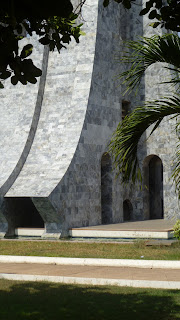
As promised, our driver picked us up at 4:30 a.m. He drove us out of town, and gradually up hill. We passed through the still-sleeping town of Quiroga and onto a dirt track where we picked up our guide, Antonio.
A road winds up Volcan Cotacachi to a squadron of antenna: cell towers, tv and radio. We wound up the road until mud ruts stopped us, and the driver let us out, promising to return in the early afternoon. From the road, the rising sun showed the earth below us undercast. Otavalo was blanketed in cloud, only the peaks of neighboring volcanoes stod clear: Imbabura and Fuya fuya. Even our first volcano of the trip, Rocu Pinchicha was visible 80km away.
We left the road for a narrow footpath that lead up through the paramo grasses. Mamá Cotacachi is deemed more difficult; the last 40m or so require mountaineering equipment including ice axes, crampons and ropes. The service, with which we had contracted for the day had reminded us that the guide would take us only as far as we could climb without the additional gear.
The clouds came in quickly and within an hour, our vision was reduced to 20m or less. Our guide, sometimes only visible only as movement, always waited for us in a sheltered spot, out of the wind. When we arrived minutes later, out of breath, he offered shelter, fruit and chocolate. We ate claudias (yellow plums) and manderinas in the refuge of a rock. On more exposed sections, he peered around his hood to make sure we were following and adjusted his pace. At breaks we asked him about plants, learning some names and medicinal uses.
In the high alpine gardenhe rooted at the base of pies de gallina in search of a small creepi8ng herb. "Medicina" he told us "Contra la altitura." He pinched off a branch for us to smell. He cleaned the rest with bottled water, then tucked the leaves into a thermos of boiling water.
The route, though well maintained with carns, bisected many other trails, and without Antonio, we would have been lost. We reached a staddle after scrambling up a few pitches, and Antonio, waiting for us in the lea of a rock, offered steaming cups of tea and bread flavored lightly with anise. We peered up at Mama Cotacach's final pitch. It was steeper than we'd yte come and coated in rime ice. The ice was beginning to accumulate on my raincoat as well.
Though higher, we found the climb somehow gentler, perhaps it was simply less steep until the final ascent, or perhaps our footing was surer on the less-traveled path. But it may also have been the folklorico and andean flute eminating from the pocket of our guide, or the promise of hot tea luring us upward.





























